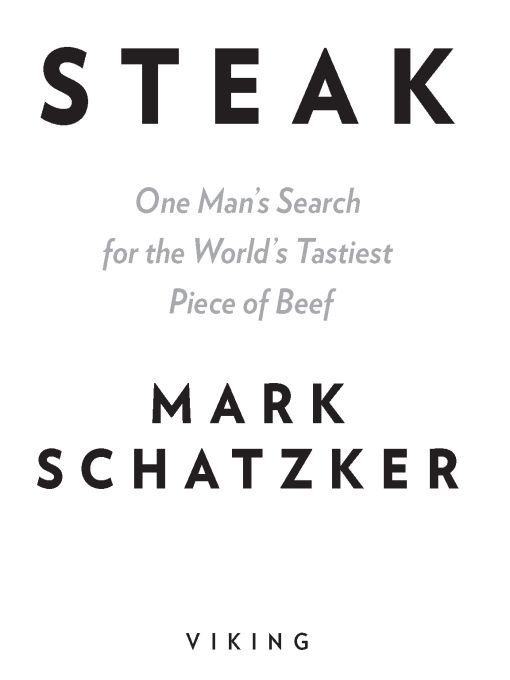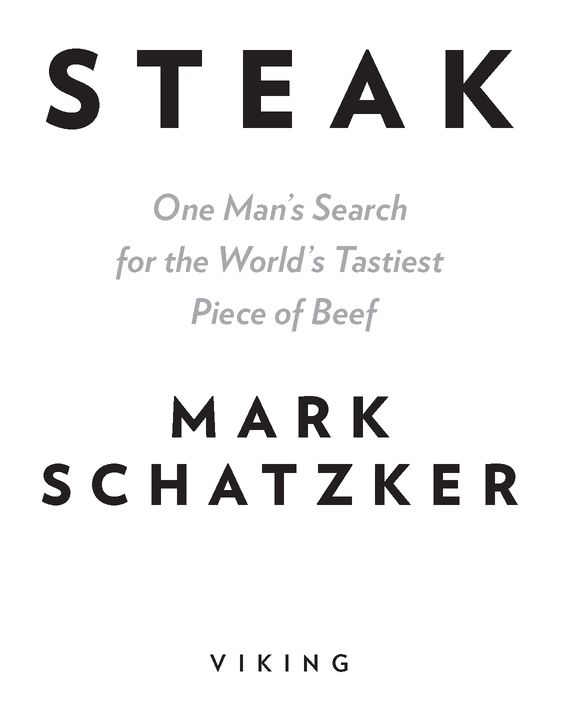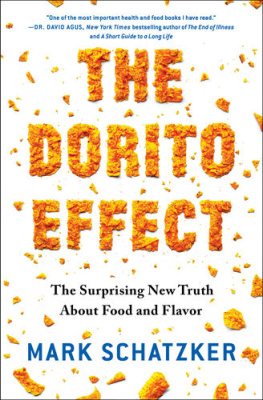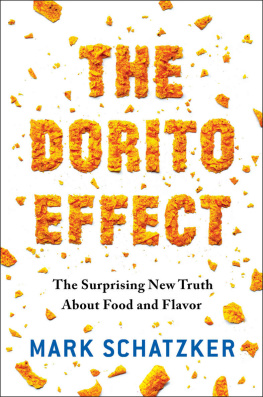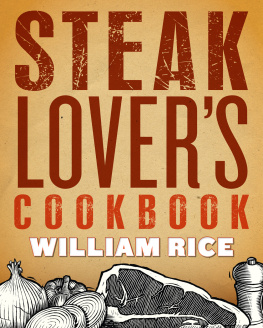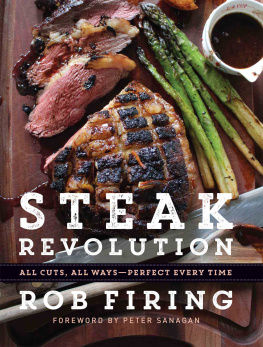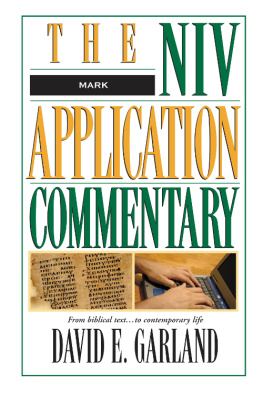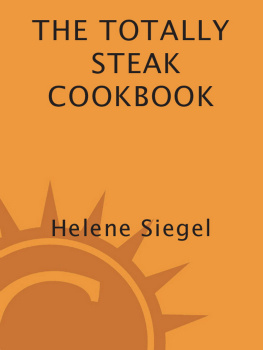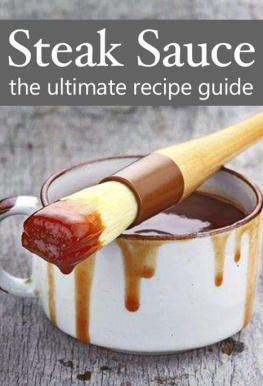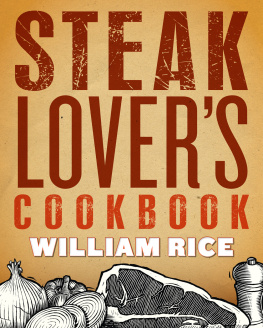Table of Contents
For my mother and father
THE PROBLEM WITH STEAK
Of all the meats, only one merits its own class of structure. There is no such place as a lamb house or pork house, but even a small town may have a steak house. No one ever celebrated a big sale by saying, How about chicken? Bachelor parties do not feature two-inch slabs of haddock. Certain occasions call for steakthe bigger the better.
Steak is king. Steak is what other meat wishes it could be. When a person thinks of meat, the picture that forms in his mind is a steak. It can be cooked, crosshatched from the grill and lying in its own juice in a pose suggestive of unmatched succulence, or it can be raw, blood-colored and framed by white fat, the steak that sleeping bulldogs in vintage cartoons dream of.
Steak earns its esteem the old-fashioned way. People dont eat it because its healthy, because its cheap, or because its exotic; it isnt considered any of these things. People love steak because of the way it makes them feel when they put it in their mouths. When crushed between an upper and a lower molar, steak delivers flavor, tenderness, and juiciness in a combination equaled by no other meat. The note struck is deep and resonant. Steak is powerful. Steak is reassuring. Steak is satisfying in a way that only the pleasures of the flesh can be.
The best steak my father ever ate was one of his first. The year was 1952, and the steak was served at an establishment in Huntsville, Ontario, called MacDonalds Restaurant. (Not to be confused with McDonalds, the worlds largest fast-food chain.) At $3.95, it was a high-priced item, considering that my father would earn all of $35 that summer as assistant director at a boys camp. An immigrant kid bent on med school, he found himself with money in his pocket for the first time in his life. On his first day off, he hitchhiked into town and bought himself a steak. It arrived sitting next to a pile of fried mushrooms, and it was huge: a sirloin, an inch thick and a foot wide, its edges drooping over the side of the plate. Nearly half a century after eating it, my father is still moved by memories of the experience. He calls it the fulfillment of my gustatory dreams.
The best steak my cousin Michel Gelobter ever ate was in the Sierra Nevada during the summer of 1980. He was working at a pack station high up in the mountains, living in a small shack with two other guides. Farther down the slopes, horses and cattle were grazing the summer pastures. He saw the cow alive before it became his meal. It was an unusually tall black-and-white castrated malea steerstanding in a corral, where it was getting fat on hay, sweet sagebrush, and grass. A few weeks later, his boss delivered meat up to the cabin, and the men started with the tenderloin, which is known in fancy talk as the filet mignon. They put it in a pan with salt and pepper, then placed the pan inside a propane stove set to broil. Michel doesnt remember cutting the steak or chewing it, but he does remember the flavor. It tasted buttery, he says. It was just slightly tougher than pt and unbelievably juicy. The steak brought all three men to the same level of extreme astonishment. I dont think any of us had ever had anything like it, Michel recalls. It felt like a freak of nature. It was the best steak wed ever had. When the steak was finished, Michel went over to inspect the remaining raw beef. It was a dark brownish red, with lots of streaks of white in it. Since then, my cousin has been searching. He has eaten a fair amount of steak, some of it very good, but none of it equal to the Sierra Nevada steak of 1980.
The best steak I ever ate gave way between my teeth like wet tissue paper under a heavy knife. There was a pop of bloody, beefy steak juice and I had to close my lips to keep any of it from escaping. The problem is, this steak lives only in my imagination. I havent actually tasted itnot yet, anyway. Its a false memory, of the culinary variety.
There have been, certainly, remarkable steaks in my past, most notably one at a Peruvian chain restaurant in a suburban mall in Santiago, Chile. It was served on its own plate, separate from the French fries, allowing the juice to pool in a manner that seemed premeditated. It was not the most tender steak I have ever eaten, but its deliciousness floored me. When I was done eating it, I raised the plate to my mouth, tipped it up, and gulped the juice in one long, excellent sip. I was ready to order another one, but I had a plane to catch.
Steak came to me the same way consciousness did. One day I woke up, and it was there. My father started grilling it when I was around nine, as I recall, which is to say thats when he started sharing steak with his youngest son, because he had been buying it and cooking it regularly ever since the trip to MacDonalds Restaurant. By the age of eleven, I knew the difference between a New York Strip and a T-bone (the bone). When my parents visited their three boys at summer camp, they would bring cold steak, black cherries, and icy cans of Coca-Cola.
My relationship with steak started getting, as they say, complicated in the early 1990s. My eldest brother, Erik, moved to South America and began sending regular dispatches on all the great steak he was eating. Every time I spoke to him on the phone, he evangelized about his latest filet or rib eye, and I would hang up jealous and hungry. One day he told me the secret to a great steak: season it only with salt and pepper. I went out and bought the most expensive steaks I could find and did as he said. The piece of meat on the end of my fork tasted like textured salt water.
I did not give up. Most of the steaks I cooked resulted in textured salt water, but occasionally there was a standout. I bought a strip loin at an above-average grocery store one day and pan-fried it according to a Julia Child recipe, and it tasted so good I felt like taking to the streets and raving about its deliciousness through a megaphone. The next day, I returned to the same store and bought an identical-looking strip loin. It was terrible.
I began chasing steak in earnest the year I got married. My wife and I went to Tuscany for our honeymoon, and on our second night there we ate at a restaurant in Florence called Del Fagioli, a cozy little spot with checkered tablecloths and big flagons of Chianti. The waiter did not recommend pasta, veal marsala, or anything else I had, until actually visiting Italy, thought of as Italian food. His advice: Get the steak. We did, and when I swallowed the first bite, I let out a string of four-letter words and fell silent for a duration lasting more than a minute. Then I swore some more. The steak was that good.
A few years later, I found myself on what may turn out to be the greatest journalistic assignment of the century. To celebrate its twentieth anniversary, a glossy travel magazine called Cond Nast Traveler asked me to travel around the world in eighty days, the sole condition being that I wasnt allowed to fly. I saw it as a well-funded steak excursion, and the first night I found myself driving through Chicago, a city famous for its excellent and huge steaks. I went to one of the pricier steak houses, one that claims to keep its own perfect bull down in Kentucky who has the enviable job of siring every one of the cows that provide the restaurants steaks. The rib eye they served me looked perfect: black on the outside and red in the middle. It tasted like grilled tap water. A few days after that, still heading west, I drove over the Sierra Nevadanot too far from my cousins pack campand dropped thrillingly down into California. That night I ate in the Napa Valley, and the steak was so good I decided to have a look at the local real estate prices, which ended up spoiling an otherwise perfect evening.

